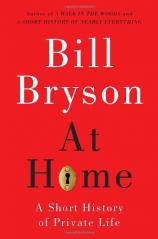At Home: A Short History of Private Life
Review
At Home: A Short History of Private Life
Bill Bryson just can’t help it. He writes funny, even when he’s being serious, as he is in this latest history of how people have lived over the centuries. This subject could be dry as toast in another author’s hands, but with his curious nose buried firmly in historical research while his waggish tongue is planted firmly in cheek, Bryson serves up a rich banquet of utterly fascinating and sometimes horrifying facts of where and how people have slept, eaten, made a living, built homes and monuments, frolicked, traveled, given birth and been laid to rest.
Bryson, who grew up in America’s Midwest, has settled with his family into an 1850s vicarage in the Norfolk region of eastern England. The manse, as it would have been called at the time of construction, was typical of parsonages in an age when the local vicar was customarily the son from a wealthy family, chosen by his father to enter the clergy. Most of us, by virtue of Jane Austen and other authors of the day, are aware of the arcane social hierarchy of 19th-century England. These customs are but one of many that Bryson explores to provide a vivid and often humorous history of civilization. AT HOME is much more than a story of British living, however. Bryson uses his historic home as a focal point to examine and describe, under his penetrating and amused eye, how humans of all cultures have adapted, evolved and comported themselves throughout our complicated history.
Bryson’s examination of food preparation and ways to determine which are edible and which will kill you is as fascinating as it is hilarious and horrifying. You can imagine how far-reaching those skills have become, leading to discoveries in food preservation, plants that cure disease, discovery of germs, even theories about what caused the witchcraft scare of the 1690s.
Did you know that parks weren’t created for leisurely strolls, ball games and picnics? Parks arose from a need to find ways to deal with the overflow of bodies buried, usually several coffins deep, causing hideous, sometimes lethal gases and growing mounds in the church yards and small, designated areas in large cities. Some bright fellow decided that if you buried bodies in large, unused open spaces and planted trees around them, nature would take its course, help the trees and lawns (another result of graveyards) to flourish, and the ghastly situation would be resolved.
As people were attracted to these open vistas of trees and grass and started strolling and picnicking amongst the gravestones, parks were born. This in turn launched a several-decades-long search of the planet for exotic botanical specimens to bring back to adorn the landscape, which included the expedition of the famous Beagle –-- the ship that bore Charles Darwin to the South Seas and his famous discovery that changed how we looked at our existence. It also created a career called landscape architecture, which led to… This is how the book goes --- one thing leads to another.
And fashion. We vain, silly humans go to great lengths and physical discomfort to adorn ourselves. One look at the current piercings and tattoos and women staggering about on five-inch stiletto heels shouldn’t surprise us that in the 18th and 19th centuries, the attempts to glorify our bodies could prove lethal. Men and women alike painted their faces with lead-based paints, resulting in death and permanent disfigurement. They corseted themselves (men, too) into punctured lungs, broken ribs, congestive heart failure and miscarriages, all for the sake of vanity. It was not uncommon for wigs, which were seldom removed even for sleep, to catch fire and disfigure or even kill the wearer. Voluminous petticoats proved not only ungainly, but a fire hazard if the wearer backed too close to an open grate. A decade of decadence was celebrated by admirers of fashion maven Beau Brummel, who attracted a daily audience that included the Prince of Wales, three dukes, a marquess, two earls and other lucky “dandies” who assembled in his dressing room to watch him bathe, dress and ready himself for a day of…well, looking utterly smashing. There are no records that he did anything else. At least Lady Gaga sings for a living.
Upon reading this delightful and fascinating book, one wonders if experience is such a great teacher as we watch our progress from the cave to our comfy, sanitary surroundings. Bryson muses that perhaps future generations will find us as comical and confusing as we see our forebears.
Reviewed by Roz Shea on December 22, 2010
At Home: A Short History of Private Life
- Publication Date: October 4, 2011
- Genres: Nonfiction, Sociology
- Paperback: 592 pages
- Publisher: Anchor
- ISBN-10: 0767919394
- ISBN-13: 9780767919395





